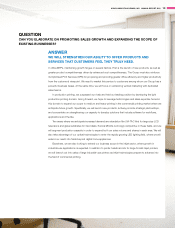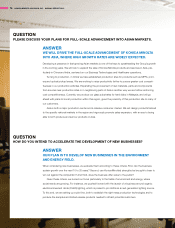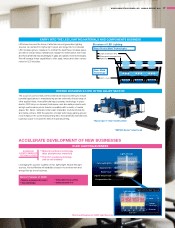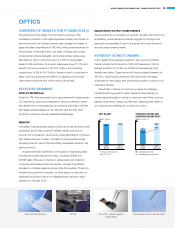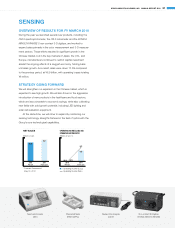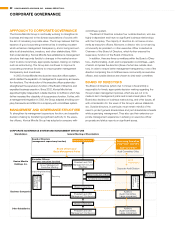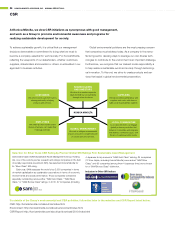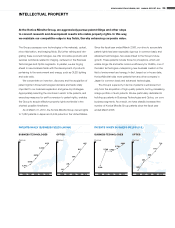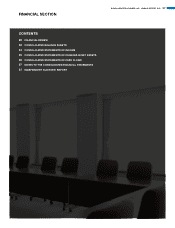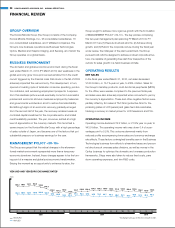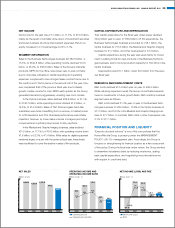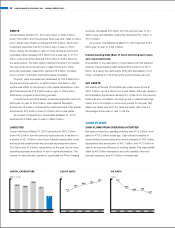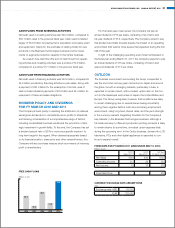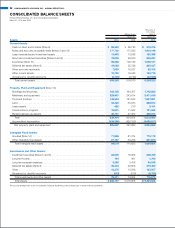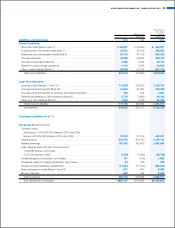Konica Minolta 2010 Annual Report Download - page 25
Download and view the complete annual report
Please find page 25 of the 2010 Konica Minolta annual report below. You can navigate through the pages in the report by either clicking on the pages listed below, or by using the keyword search tool below to find specific information within the annual report.
In principle, the Board of Directors meets once a month. Out-
side directors receive advance briefings on agenda items in order
to ensure they understand the items and thereby facilitate more
lively discussion at meetings of the board. In particular, explana-
tions of important management decisions are provided by the
relevant executive officers. In FY March 2010, overall attendance by
outside directors at meetings of the Board of Directors and its three
committees exceeded 90% on average.
Every year, each board member provides an evaluation of the
Board of Directors, which serves as a general review of the compo-
sition and administration of the board and its three committees, as
well as other matters. This evaluation is summarized and discussed
by the outside directors, the chairman, and the president, in an
effort to enhance corporate governance.
COMMITTEE ROLES AND FUNCTIONS
NOMINATING COMMITTEE
The key role of the Nominating Committee (which met five times in
FY March 2010), is the selection of director candidates who will be
presented for approval before the general meeting of shareholders.
When appointing internal and outside directors, the Nominating
Committee selects candidates in accordance with the Group’s
proprietary selection criteria. In selecting candidates for outside
directors, key criteria include independence, and experience in
corporate management. The Nominating Committee also clearly
documented criteria regarding the independence of outside direc-
tors, stipulating, among other conditions, that candidates shall have
no significant business relationships with the Group, or personal
relationships with its executive officers. Further, to address the
concern that long-serving outside directors may eventually become
less independent, Konica Minolta limits their re-nomination to, in
principle, a term of four years.
COMPENSATION COMMITTEE
The Compensation Committee (which met six times in FY March
2010) formulates policies for executive compensation, and deter-
mines the amount of individual compensation for directors and execu-
tive officers. The compensation system is designed to raise motivation
among executive officers to continuously improve business results in
the mid- to long-term, and contributes to enhancing overall Group
value by providing a benchmark for attracting and retaining personnel
willing to ensure the company’s future development.
•Compensationfordirectorsandexecutiveofficers
Compensation for inside directors, who are responsible for super-
vising Group management, comprises base salary, and stock
options for stock-linked compensation to encourage long-term
performance. The compensation of outside directors is base salary
only. The target compensation of executive officer packages is 60%
in base salary, 20% in short-term performance-based cash
bonuses as an incentive, and 20% in stock options for stock-linked
compensation as a long-term incentive. The amount of perfor-
mance-based cash bonuses are determined by business perfor-
mance levels for the fiscal year in question, and by the degree to
which fiscal year performance goals have been met.
The amount of compensation to directors and executive officers
recorded as expenses for FY March 2010, is as shown below.
Compensation (millions of yen)
Total Total base salary
Performance-
based
cash bonus
Stock
option-based
compensation
Amount Persons Amount Persons Amount Persons Amount
Directors Outside 41 5 41 – – – –
Inside 152 5 127 – – 5 24
Total 193 10 168 – – 5 24
Executive Officers 809 23 525 23 151 23 132
Note 1: As of March 31, 2010, there are four outside directors, three internal directors
(excluding those who serve concurrently as executive officers), and 22 execu-
tive officers.
Note 2: In addition to the five inside directors shown above, the company has another five
inside directors who concurrently hold executive officer posts, and compensation
to these directors is included in the executive officer compensation noted above.
Note 3: Regarding performance-based cash bonuses, the amounts stated are those
which should be recorded as an expense for FY March 2010.
Note 4: Regarding stock option-based compensation, the amounts stated are those
which should be recorded as an expense, based on an estimation of the fair
value of the new share subscription rights issued to directors (excluding outside
directors) and executive officers as part of their compensation.
Note 5: Compensation figures for executive officers in the table above include base
salaries and performance-based cash bonuses provided to the 14 executive
officers who are primarily responsible for the company’s subsidiaries, and which
are partially paid for by the subsidiaries.
AUDIT COMMITTEE
The Audit Committee (which met 14 times in FY March 2010)
audits executive management decisions to see whether they are
legitimate and proper and monitors and verifies internal control
systems. The committee also reviews the methods used and
results provided by the independent auditors, and decides on
proposals for the selection, dismissal, and/or non-reelection of the
independent auditors, as well as approving their compensation.
The Audit Committee works with the independent auditors and the
Corporate Audit Division, which acts as an internal audit office, to
enhance audit efficiency and effectiveness, while also receiving
regular reports from executive officers responsible for the Risk
Management Committee, Compliance Committee, and other
internal control systems.
In principle, the Audit Committee meets prior to meetings of
the Board of Directors, so that the committee members can pres-
ent their opinions to the meeting of the Board of Directors, if
deemed appropriate.
To further enhance the effectiveness of the Audit Committee, a
separate Audit Committee Office with its own dedicated staff has been
established as a secretariat independent of any operating division.
For details of the Group’s corporate governance, follow the link to the website listed below.
http://www.konicaminolta.com/about/csr/governance/index.html
KONICA MINOLTA HOLDINGS, INC. ANNUAL REPORT 2010 23


